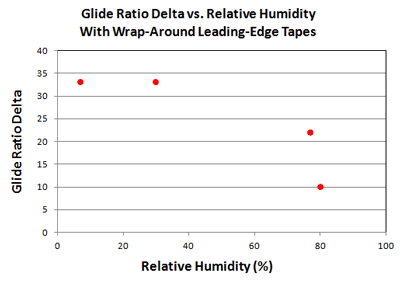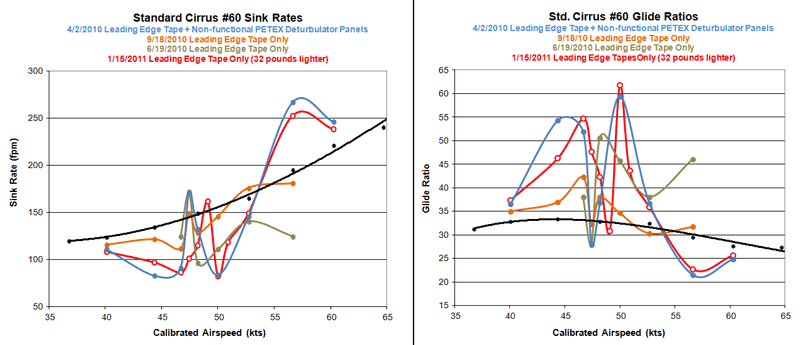|
|
4th Leading-Edge-Tape-Only Performance Measurement (Revised 10/29/2011)
Below are four sets of sink-rate measurements on Standard Cirrus #60 modified by a 2" wide, 0.0027" thick tape wrapped around the leading edge of the wing. This was added years ago as a preconditioner for the boundary flow that reattaches at the site of deturbulator panels in order to stimulate aeroelastic vibration modes that benefit performance. Noticing large performance swings with extreme airspeed sensitivity even when the deturbulator panels were known to be disfunctional, I began taking measurements without the panels to verify my theory. The following graph show four separate measurements, one with disfunctional deturbulator panels and three with the panels removed and only the leading edge tape remaining.
The curious performance notch is characteristic of polars when tape on the leading edge of the wings provides a rear-facing step at the tape edge on the upper side of the wing. This feature goes away when a narrow tape is used on the under side of the leading edge. Click for more on this. It also goes away when functioning deturbulator panels are installed at the reattachment point on the upper wing surface. In that case, it leaves a large performance peak at about the same airspeed. Click for more on this. The cause of the notch is not understood at this time.
The airspeed of the notch appears to be very sensitive to the all up weight of the glider. It is at precisely the same speed, 49 KIAS, in the three earlier measurements. But, in the last measurement (red) it has moved two knots higher. This appears to be due to a reduction in the all up weight of 32 lbs. By my estimate, in the 50 KIAS speed range, each knot corresponds to a 0.2 degree change in AOA, so the shifted notch corresponds to a -0.4 change in AOA.
Except for the position of the notch, there is remarkable agreement between the 1/15/2011 (red) and 4/2/2010 (blue) curves. The agreement at 60 and 65 KIAS indicates that the severe performance loss at 60 KIAS is real. There is also agreement in the amplitude of the performance peaks to the right of the notch. On the left side, however, they differ. The rounded shape of the curve fit for the 4/2/2010 (blue) data is likely due to measuring points on each side of the peak and missing the peak itself. In that case, the blue peak on the left side of the notch likely matches the right side.
The reason for the large amplitude variations in these curves appears to be due to humidity. This comes as a great surprise, as formally I thought that the only humidity issue related to condensation under deturbulator panel membranes. Now, it appears that there is a critical humidity dependence in the beneficial flow dynamics at, or near, the rear-facing step formed by the tape. The following graph plots the L/D amplitude delta between the notch value and the highest neighboring peak for each of the four curves above vs. relative humidity at the mean altitude of the measurements. Although, there are no points in the 30-75% RH range, it appears that the performance potential from small (0.0027") rear-facing steps above and below the leading edge of a Wortmann airfoil is very large until the RH exceeds 70%. Then it plummets to nothing, essentially switching off. This relationship is astounding, as are the implications, if this discovery proves to be real!

It is thought that, even without condensing, water molecules in sufficient concentration adhere to the wing and tape surfaces, thereby changing the effective surface friction seen by the thin laminar boundary flow near the leading edge of the wing. This is a remarkable finding as it seems to indicate that molecular level phenomena are having a large effect on glider performance.
The overall pattern of these four curves is consistent, indicating that, surprising as it may seem, this leading-edge deturbulator phenomenon is in fact real and needs to be taken seriously by the aeronautics community!
